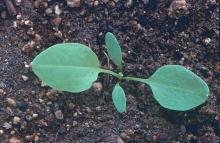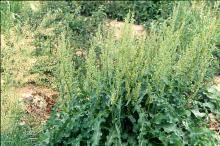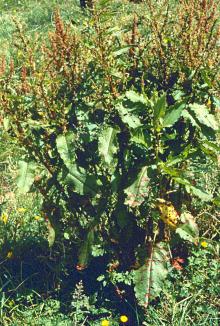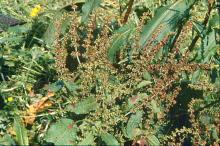2,4-D or dicamba (Clarity, Rifle) or picloram (Tordon)
Rate A mixture of each product 1 lb ae/50 gal of water for spot treatments
Time Apply before flower elongation.
Remarks Repeated treatments needed to control regrowth. Dicamba is effective on curly dock but not on broadleaf dock. Picloram is effective on both species and is registered for use on grazing and non-cropland.
Caution Most formulations are restricted-use herbicides. Do not contaminate water. Potatoes, beans, and many other broadleaf crops are sensitive to these herbicides. Do not use picloram in diversified crop areas.
Site of action (all) Group 4: synthetic auxin
Chemical family (2,4-D) phenoxy acetic acid; (dicamba) benzoic acid; (picloram) pyridine
2,4-DB amine or 2,4-D ester (Butyrac or Butoxone)
Rate 1 to 1.5 lb ae/A
Time Apply before flower stalk elongates. Repeated applications are necessary.
Remarks This treatment is selective on legumes and grass crops.
Caution Spray 30 days before feeding forage. Avoid drift to sensitive crops.
Site of action Group 4: synthetic auxin
Chemical family Phenoxy acetic acid
aminopyralid (Milestone)
Rate 1 to 1.5 oz ae/A (4 to 6 fl oz/A)
Time Apply to actively growing plants before the bud stage of growth.
Remarks A nonionic surfactant at 1 to 2 quarts/100 gal of spray enhances control under adverse environmental conditions.
Caution Do not let spray drift onto desirable vegetation. Many forbs (desirable broadleaf plants) can be seriously injured or killed. Do not exceed 7 fl oz/A Milestone per year.
Site of action Group 4: synthetic auxin
Chemical family Pyridine
chlorsulfuron (Telar)
Rate 0.75 oz ai/A (1 oz/A)
Time Apply to young, actively growing weeds.
Remarks Do not apply to frozen ground. Constantly agitate while mixing in spray solution. Add 0.25% v/v nonionic surfactant to the spray mixture. Apply with ground equipment in at least 10 gal/A carrier.
Caution Avoid contact with sensitive crops. Labeled for pasture, range, Conservation Reserve Program (CRP), and non-cropland use only. Do not treat powdery, dry soils or light, sandy soils unless rain is likely after treatment.
Site of action Group 2: acetolactate synthase (ALS) inhibitor
Chemical family Sulfonylurea
glyphosate
Rate 2.25 to 3.75 lb ae/A
Time Apply at early heading.
Remarks Glyphosate is a foliar-active herbicide.
Caution Glyphosate controls grasses as well as other vegetation in treated areas.
Site of action Group 9: inhibits EPSP synthase
Chemical family None generally accepted
metsulfuron (Ally and others)
Rate Ally: 0.06 to 0.12 oz ai/A (0.1 to 0.2 oz/A)
Time Apply to young, actively growing weeds.
Remarks Do not apply to frozen ground. Constantly agitate while mixing in spray solution. Add 0.25% v/v nonionic or silicone surfactant to the spray mixture.
Caution Avoid contacting sensitive crops. Consult labels for crops on which each product can be used. Do not treat powdery, dry soils or light, sandy soils unless rain is likely after treatment.
Site of action Group 2: acetolactate synthase (ALS) inhibitor
Chemical family Sulfonylurea
sulfometuron (Oust)
Rate 2.25 oz ai/A (3 oz/A)
Time Apply preemergence to early postemergence.
Remarks Recommended for use on non-cropland only. Rate depends on annual rainfall. Do not apply to frozen ground. Constantly agitate while mixing in spray solution. Add 0.25% v/v nonionic surfactant to increase activity of postemergence applications. Apply with ground equipment in at least 15 gal/A carrier.
Caution Keep sulfometuron methyl out of cropland. Equipment used to apply this material should be dedicated to non-cropland uses only. Do not treat powdery, dry soils or light, sandy soils unless rain is likely after treatment.
Site of action Group 2: acetolactate synthase (ALS) inhibitor
Chemical family Sulfonylurea





